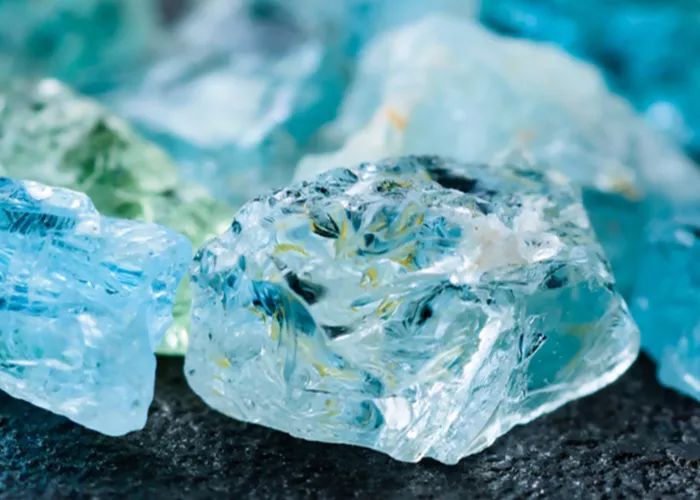Aquamarine, a variety of the beryl family, is a popular gemstone known for its beautiful blue to blue-green hues. The color of aquamarine can vary significantly, and this variation in color plays a crucial role in determining its value. In the world of gemstones, certain colors are more desirable and, consequently, more expensive. Understanding the factors that contribute to the value of different aquamarine colors is essential for both jewelers and consumers.
Color Spectrum of Aquamarine
Blue-Green to Blue
Aquamarine typically exhibits a range of colors from blue-green to pure blue. The most common color is a light to medium blue with a slight greenish tint. This color is often associated with the sea, which is where the name “aquamarine” (Latin for “water of the sea”) originates. The color is caused by the presence of iron ions in the crystal lattice of the beryl. The intensity of the blue color can vary, with some stones having a more vivid blue while others may be paler.
Color Zoning
Many aquamarines show color zoning, which means that different parts of the stone may have slightly different colors. This can be seen as bands or areas of different intensities within the gemstone. Color zoning is a natural characteristic of aquamarine and can add to its beauty. However, stones with more uniform color are generally more valuable.
The Most Valuable Aquamarine Color
Deep Blue with Slight Greenish Tint
The most valuable color in aquamarine is a deep blue with a slight greenish tint. This color is often described as “Santa Maria” or “Santa Maria Africana” in the gemstone industry. Stones with this color are highly sought after and can command a premium price. The deep blue color is associated with high quality and is considered the most desirable for jewelry.
Intensity and Saturation
The intensity and saturation of the blue color are also important factors in determining the value of aquamarine. A stone with a more intense and saturated blue color will be more valuable than one with a paler or less saturated color. The color should be vivid and evenly distributed throughout the stone.
Clarity and Transparency
In addition to color, the clarity and transparency of the aquamarine also play a role in its value. A stone with fewer inclusions and a high level of transparency will be more valuable. Aquamarines are often cut to enhance their color and clarity, and a well-cut stone can significantly increase its value.
Factors Affecting Aquamarine Color
Geological Origin
The geological origin of aquamarine can influence its color. Different deposits around the world produce aquamarines with varying colors. For example, aquamarines from Brazil are known for their deep blue color, while those from Madagascar may have a more greenish tint. The presence of different trace elements in the crystal lattice can also affect the color of the stone.
Treatment and Enhancement
Some aquamarines may be treated to enhance their color. Heat treatment is a common method used to improve the color of aquamarine. This process can intensify the blue color and reduce any greenish tint. However, treated aquamarines are generally less valuable than untreated stones.
Cut and Proportion
The cut and proportion of the aquamarine can also affect its color. A well-cut stone will enhance the color and make it more vibrant. The shape of the cut should be proportionate to the stone’s size, and the facets should be well-polished to bring out the best in the color.
Market Trends and Pricing
Price Range
The price of aquamarine can vary widely depending on its color, clarity, and size. High-quality aquamarines with a deep blue color can command prices in the range of several hundred to several thousand dollars per carat. Larger stones are generally more valuable, and stones over 10 carats can be particularly rare and expensive.
Market Demand
The demand for aquamarine has been increasing in recent years, especially for stones with a deep blue color. This has led to an increase in prices, particularly for high-quality specimens. The popularity of aquamarine in jewelry, especially in engagement rings and other fine jewelry, has contributed to its rising value.
Investment Potential
Aquamarine has also been considered an investment gemstone. Stones with a deep blue color and high quality can appreciate in value over time. However, like all gemstones, the market for aquamarine can be volatile, and prices can fluctuate based on supply and demand.
Conclusion
In conclusion, the most expensive aquamarine color is a deep blue with a slight greenish tint, often referred to as “Santa Maria” or “Santa Maria Africana.” This color is highly prized for its beauty and rarity. The value of aquamarine is determined by a combination of factors, including color, clarity, size, and origin. Understanding these factors can help both jewelers and consumers make informed decisions when purchasing aquamarine jewelry. Whether for personal adornment or as an investment, aquamarine remains a popular and valuable gemstone in the world of jewelry.
Related topic:
- Natural vs Synthetic Aquamarine: What Is the Difference
- What Is the Best Shape for an Aquamarine Ring
- What Is a Raw Aquamarine Ring


